How to Make Durian Puff? 8 Easy Steps!
To make a durian puff, you will need to select high-quality durian fruit for the filling and prepare a custard mixture that perfectly balances sweetness with the durian’s strong flavor.
The puff pastry requires a butter-rich dough, which must be rolled and folded several times to create the necessary layers. This dough should be chilled to maintain its shape during baking.
Baking should be done carefully to achieve a golden, flaky crust without compromising the creamy filling. Once baked, the durian puffs should be served fresh or stored correctly to maintain their taste and texture.
The creation of durian puffs involves two main components: the durian custard filling and the puff pastry.
The filling is made by blending durian flesh with a sweet custard base, while the pastry is a combination of flour, butter, and water, worked together to form multiple layers.
Here are the general steps to make durian puffs:
Enjoy the perfect bite of tropical indulgence with homemade durian puffs, boasting a flaky crust and lush filling.
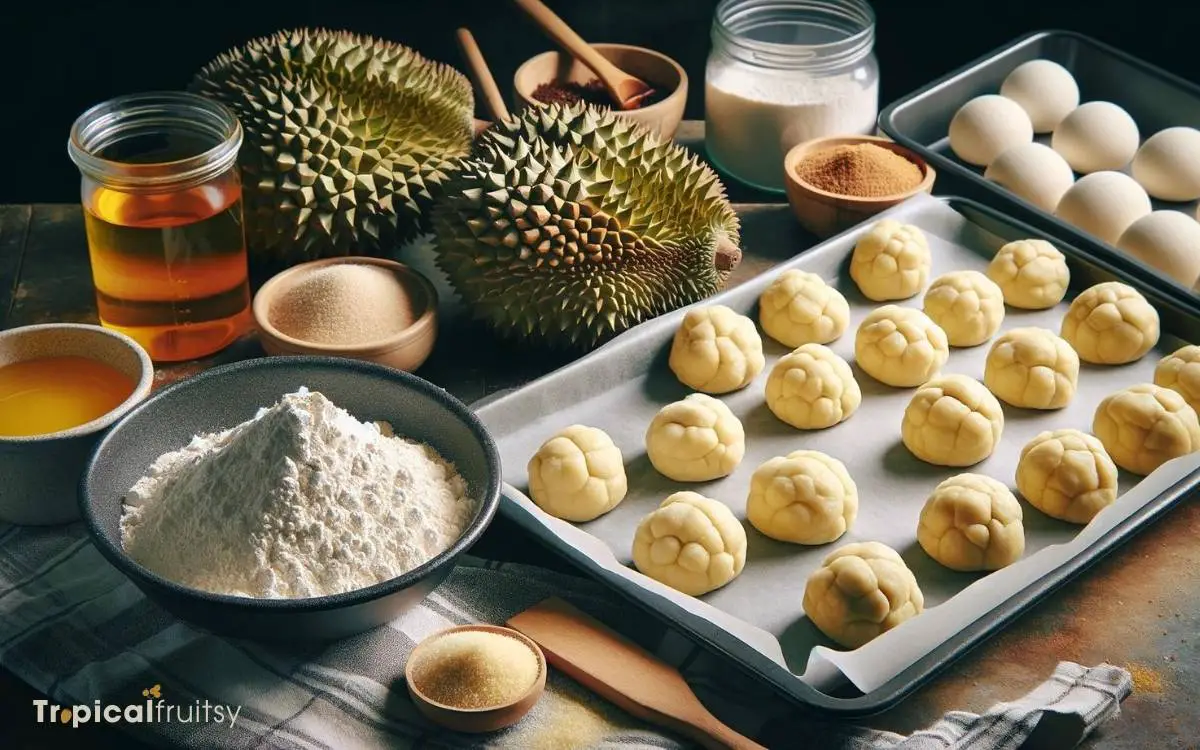
Key Takeaway
Step 1: Selecting Quality Durian

While preparing to make durian puff, it is crucial to select a high-quality durian, as the fruit’s ripeness and flavor will significantly influence the final taste of the dessert.
A superior durian should exhibit a firm stem, indicating freshness, and a pronounced, distinctive aroma, which suggests optimal ripeness.
When assessing durian, one should scrutinize the exterior for any signs of premature harvesting, such as an excessively green husk or lack of a natural fissure.
The flesh inside should be a rich, buttery yellow, with minimal fibrous texture and free from any discoloration or fermentation that indicates overripeness or spoilage.
A meticulous selection process ensures that the durian’s robust, complex flavor profile is preserved in the resulting confection.
Step 2: Preparing Durian Filling
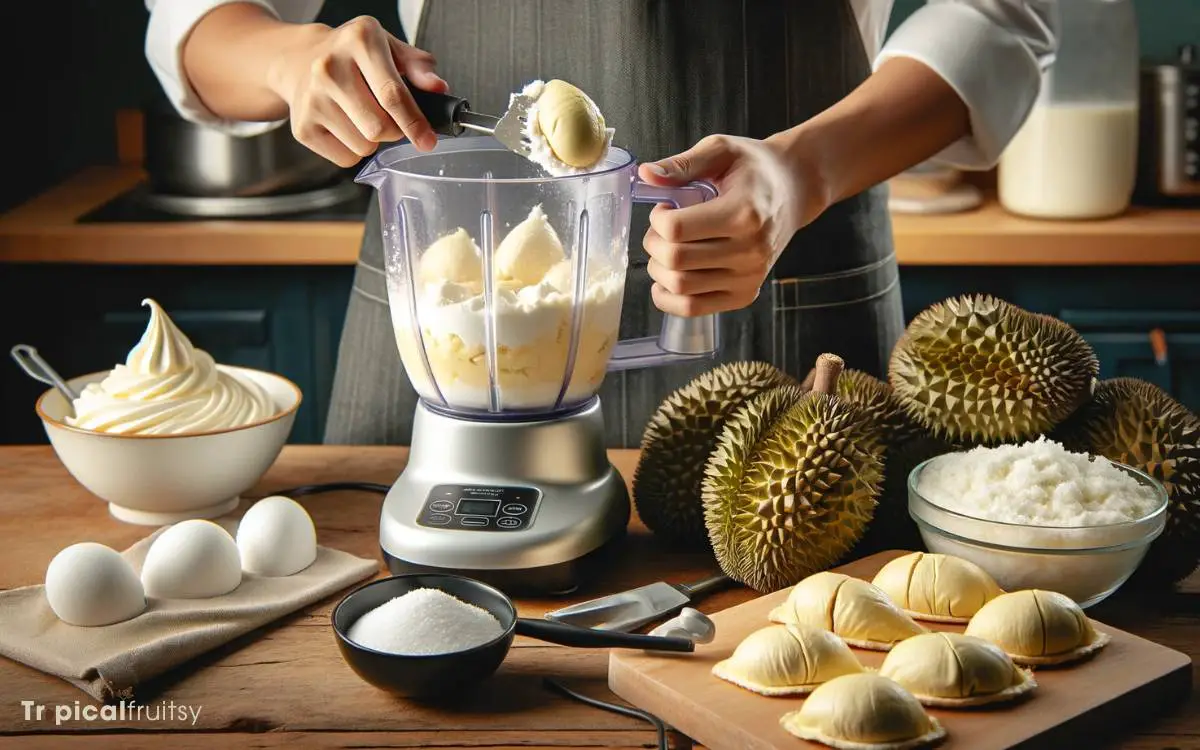
After selecting your high-quality durian, proceed to prepare the filling by removing the seeds and pureeing the flesh until smooth for a rich and creamy texture.
To achieve this, use a food processor or blender capable of rendering the durian pulp into a homogenous consistency.
Be meticulous in ensuring that all seed remnants are discarded, as they can disrupt the smoothness of the filling.
The puree should be evaluated for texture and flavor. If necessary, adjust the consistency by adding a small amount of cream or milk—this will not only refine the texture but also temper the intensity of the durian for a more palatable balance.
Strain the puree through a fine-mesh sieve to eliminate any fibrous particles, thus guaranteeing a velvety filling for your durian puffs.
Step 3: Crafting Puff Pastry Dough
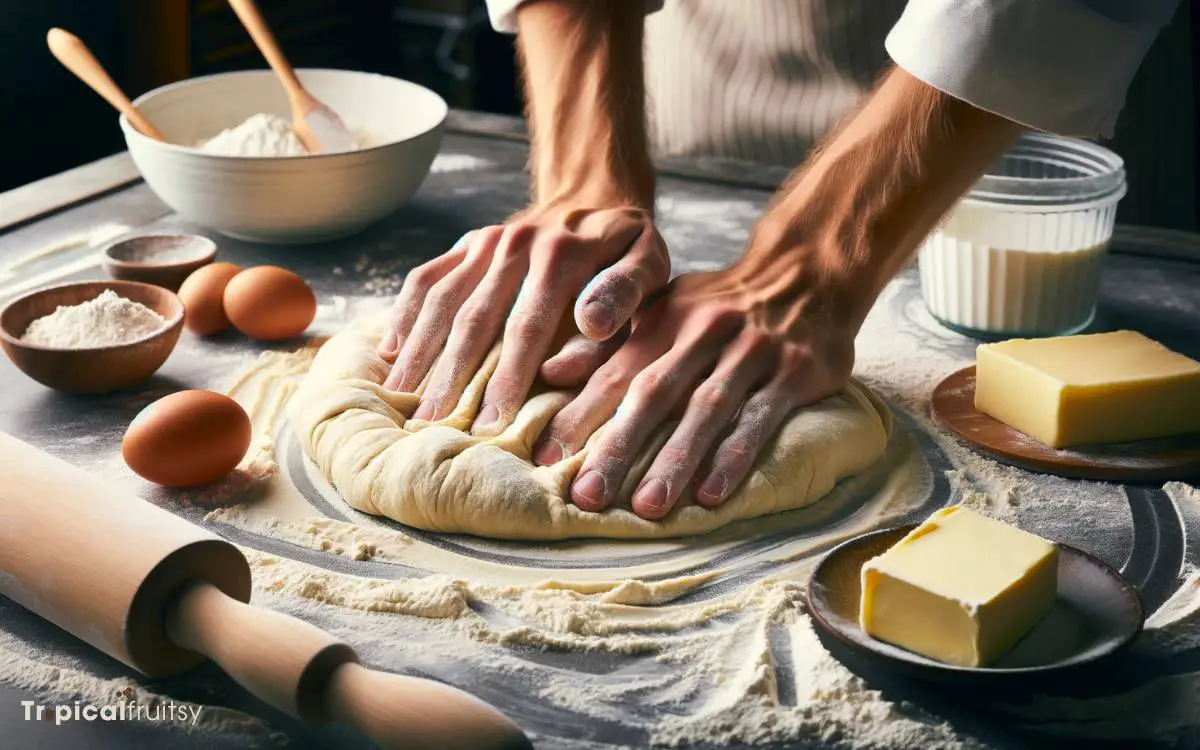
Moving to the construction of puff pastry dough, the butter layering technique is paramount for achieving the desired flakiness.
Maintaining the dough’s temperature is crucial; thus, handling chilled dough is advised to prevent the fat from melting prematurely.
The rolling and folding process, a series of precise movements, contributes significantly to the creation of multiple, delicate layers within the pastry.
Butter Layering Technique
To achieve the delicate, flaky layers synonymous with puff pastry, one must meticulously incorporate butter into the dough through a process known as lamination.
This technique requires precision and patience to ensure the butter is evenly distributed, resulting in the desired texture and flavor.
Key steps include:
- Preparation: Soften the butter to a pliable consistency without melting.
- Encasement: Roll the dough into a rectangle and envelope the butter inside, sealing the edges to prevent leakage.
- Folding: Perform a series of folds, traditionally in thirds, to create multiple layers.
- Resting: Chill the dough between folds to maintain butter’s consistency and prevent it from being absorbed into the dough.
Mastering this technique is crucial, as it directly influences the quality of the final product.
Chilled Dough Handling
Once the butter is meticulously layered within the dough, it is essential to handle the chilled dough with care to preserve the integrity of those flaky layers during the crafting of puff pastry dough.
The dough must be maintained at a cool temperature to prevent the butter from melting into the dough, which would result in a loss of lamination.
Consequently, the dough should be removed from refrigeration only for the duration necessary to execute the next steps: rolling and folding.
Utilize a lightly floured surface to prevent sticking without over-flouring, which can toughen the pastry.
Roll out the dough to a uniform thickness, and fold it neatly, maintaining straight edges and corners to ensure even layering. Return the dough to chill after each fold to sustain its workability and structure.
Rolling and Folding Tips
Mastering the rolling and folding technique is crucial for achieving the delicate, airy texture characteristic of exemplary puff pastry in a durian puff.
This meticulous process requires precision and a gentle touch to ensure the butter is evenly distributed without becoming too warm or integrating into the dough.
Key considerations include:
- Uniform Thickness: Roll the dough evenly to prevent thin spots that can lead to breakage and uneven puffing.
- Chill Periods: Rest the dough in the refrigerator between folds to maintain a cool temperature, preventing butter from melting.
- Consistent Direction: Fold and roll the dough in the same direction to encourage uniform layering.
- Sharp Edges: Maintain straight edges and corners; this helps the layers to stack properly, enabling the pastry to rise evenly.
Implementing these techniques will contribute to the creation of a superior durian puff pastry with crisp, flaky layers.
Step 4: Rolling and Cutting Dough
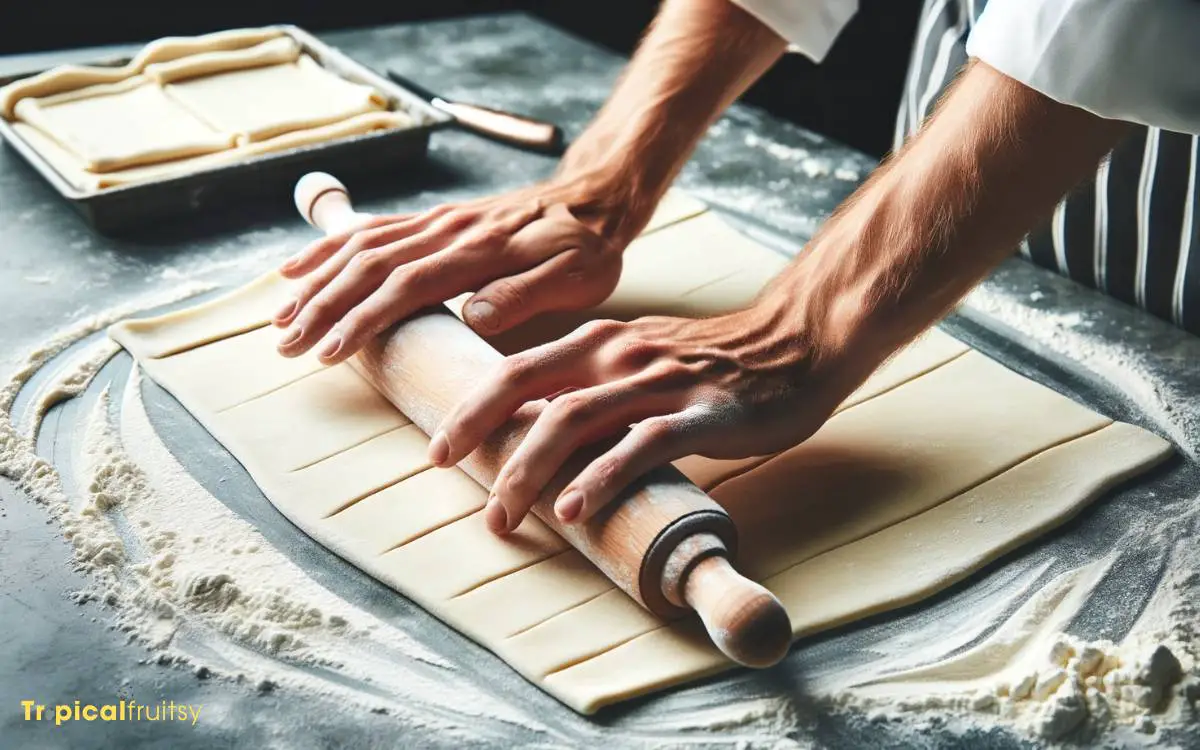
Transitioning to the rolling and cutting phase, it is critical to maintain a consistent thickness throughout the dough to ensure even baking and texture.
Precision in cutting shapes not only affects the visual appeal but also promotes uniform cooking times for each durian puff.
Utilizing tools such as a rolling pin with adjustable thickness rings and a sharp pastry cutter can significantly enhance the accuracy and quality of the final product.
Dough Thickness Uniformity
Achieving uniform dough thickness is crucial when rolling and cutting dough for durian puffs, ensuring consistent baking and texture.
To maintain even thickness across the entirety of the dough, one must:
- Utilize a rolling pin with adjustable thickness rings to achieve precision.
- Measure the thickness periodically with a ruler or a special dough thickness gauge.
- Rotate the dough 90 degrees after several passes to maintain evenness and prevent overstretching.
- Rest the dough intermittently to prevent elasticity from affecting the uniformity.
These steps contribute to a homogenous dough structure, which is paramount for uniform heat distribution during baking. This precise approach mitigates the risk of doughy or overly crisp textures in the final product.
With the dough rolled to an even thickness, we can now focus on the subsequent step: precise shape cutting.
Precise Shape Cutting
After rolling the dough to uniform thickness, the next critical step in preparing durian puffs is to cut the dough into precise shapes using a sharp cutter or knife.
This process entails the meticulous manipulation of the dough to ensure that each piece is congruent and will bake evenly.
Select a cutter that corresponds to the desired size and shape of the final product. Apply firm, decisive pressure to the dough, taking care to maintain consistency across all cuts.
The precision in this stage is paramount, as irregularities could lead to uneven baking and suboptimal texture.
The edges should be smooth and free from ragged imperfections, which necessitates the use of high-quality cutting implements. With the pieces cut to the precise specifications, the stage is set for shaping the puffs.
Step 5: Shaping the Puffs
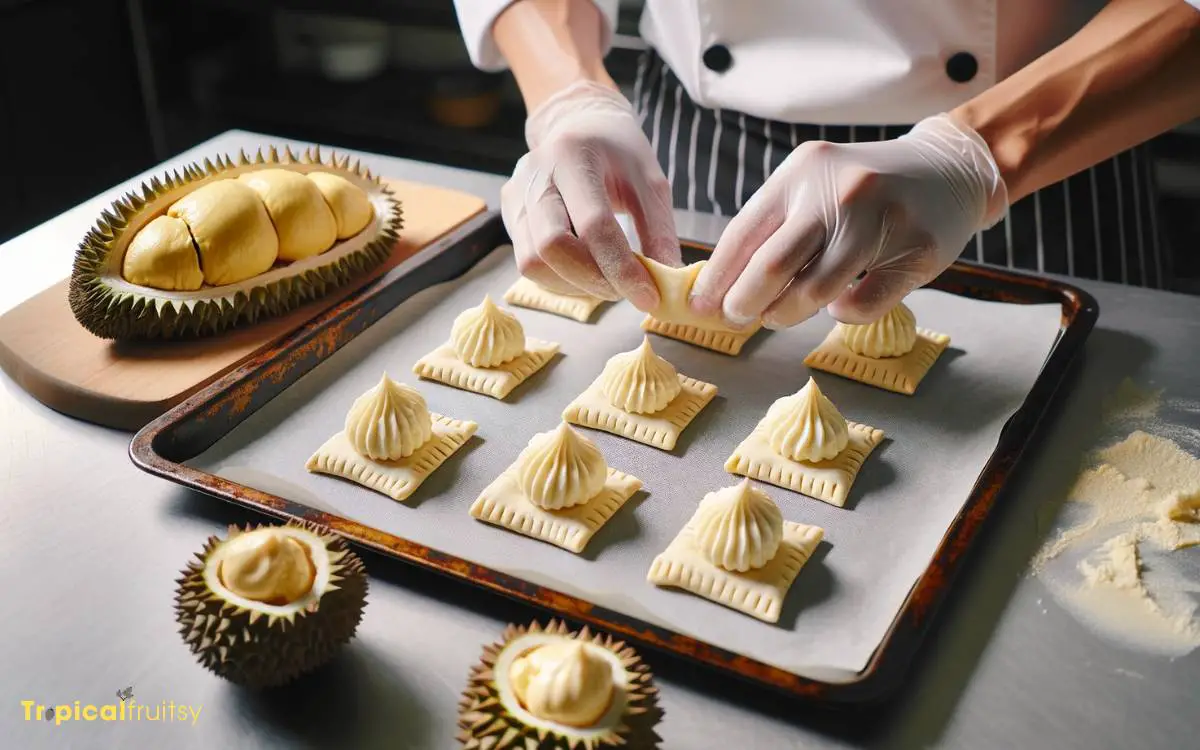
Once the durian filling is prepared, one must next focus on creating uniformly sized pastry shells that will become the puffs. Precision in shaping is paramount for ensuring consistent baking and presentation.
- Utilize a dough scoop or a measured spoon to portion the choux pastry dough to maintain uniformity.
- Gently roll the scooped dough between palms to achieve a smooth, spherical shape, taking care not to overwork the dough.
- Ensure that each ball of dough is placed equidistantly on the baking sheet to allow for even expansion during baking.
- Flatten the top slightly with a dampened finger to avoid peaked tops and to provide a stable base for the durian filling.
This meticulous approach will result in puffs of consistent size and texture, essential for a professional finish.
Step 6: Chilling Before Baking
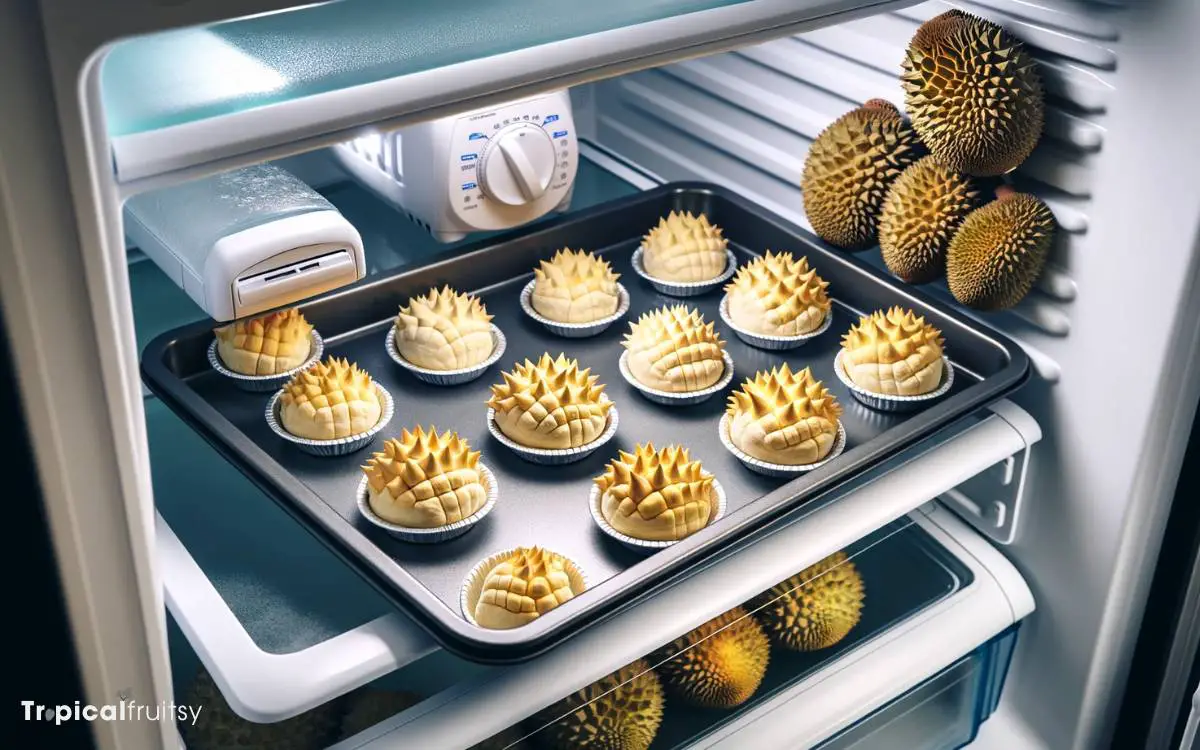
Before placing the uniformly shaped pastry shells into the oven, it is imperative to chill them in the refrigerator to ensure the dough retains its structure and yields the desired flakiness upon baking.
This chilling process, termed ‘retarding’, allows the fats within the pastry to solidify, which in turn helps in maintaining the shape of the puff and reducing shrinkage during the baking process.
By retarding the pastry shells, the evaporation of water is controlled, creating distinct, well-layered puffs.
| Duration | Temperature | Purpose |
|---|---|---|
| 30 mins | 4°C (39°F) | Initial chilling |
| 15 mins | Freezer | Quick firming |
| 10 mins | Room Temp. | Before baking |
| Variable | 4°C (39°F) | Extended retarding |
| Until firm | Freezer | For storage |
Step 7: Baking to Perfection
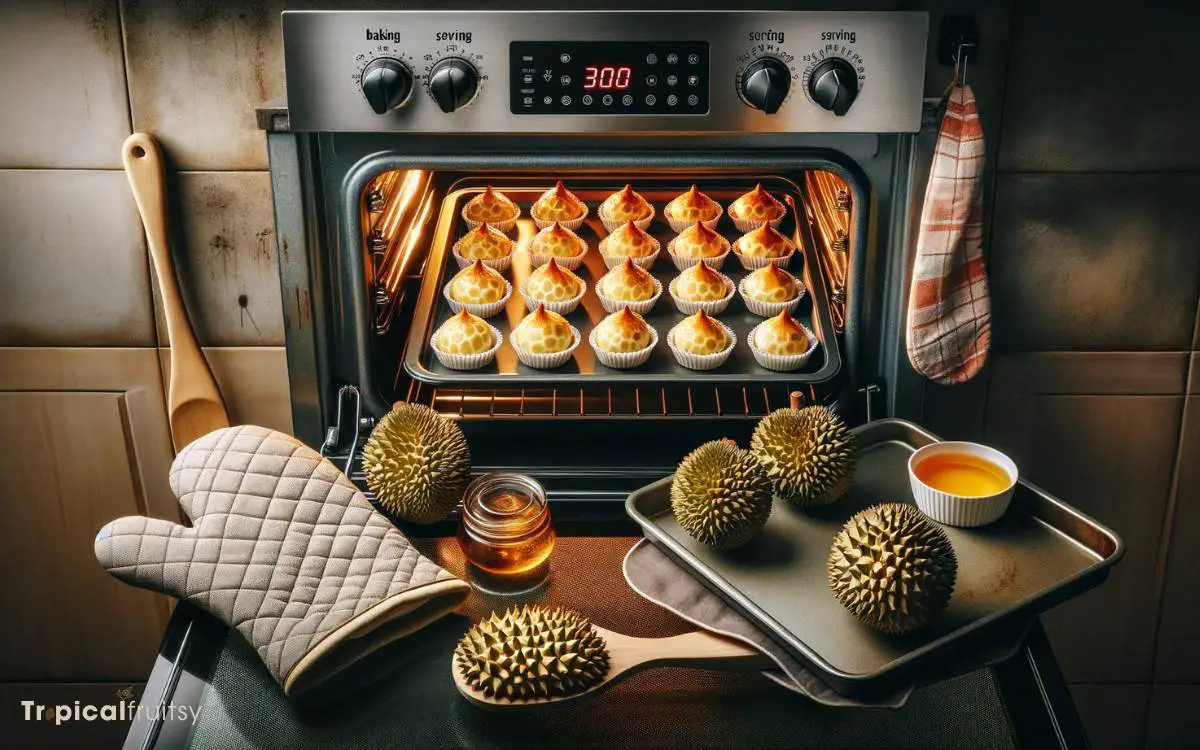
Transitioning from chilling to baking, place the durian puff pastry shells in a preheated oven at 200°C (392°F) to ensure they puff up golden and flaky.
Attaining the quintessential texture and color of the durian puffs necessitates adherence to a set of baking principles:
- Consistent Temperature: Maintain a stable oven temperature to prevent uneven baking and potential collapse of the pastry layers.
- Positioning: Situate the puffs in the center of the oven to promote uniform heat distribution.
- Timing: Vigilantly monitor the baking time, as overbaking can result in a hardened crust, while underbaking can leave the pastry doughy.
- Ventilation: If your oven has a fan-assisted feature, utilize it to circulate the air and achieve a more consistent bake.
Employ these techniques to master the art of baking durian puffs that boast a delectable balance of crispness and tenderness.
Step 8: Serving and Storage Tips

After meticulously baking the durian puffs to a golden perfection, it is crucial to understand the optimal ways to serve and store them to maintain their exquisite texture and flavor.
To serve, present the durian puffs at room temperature, which will best accentuate their delicate crust and creamy filling.
For immediate consumption, a resting period of approximately ten minutes post-baking ensures the volatiles within the durian cream settle, thus enhancing the sensory experience.
Regarding storage, encapsulate the puffs in an airtight container to preclude moisture ingress and flavor degradation.
Refrigeration is recommended for a maximum of 48 hours to preserve freshness; however, it is advisable to consume them within 24 hours.
Avoid freezing, as this can irreversibly compromise the puff pastry’s flaky texture and the filling’s nuanced flavor profile.
Conclusion
The art of creating durian puff juxtaposes the king of fruits’ pungent dominance with the delicate craftsmanship of pastry.
Through meticulous selection and preparation of durian, alongside the precise science of puff pastry production, one transcends mere baking, venturing into an olfactory challenge that dares to defy convention.
The final gastronomic paradox, a triumph of flavor encased within flaky layers, serves as a testament to culinary audacity and the malleability of cultural palates.






